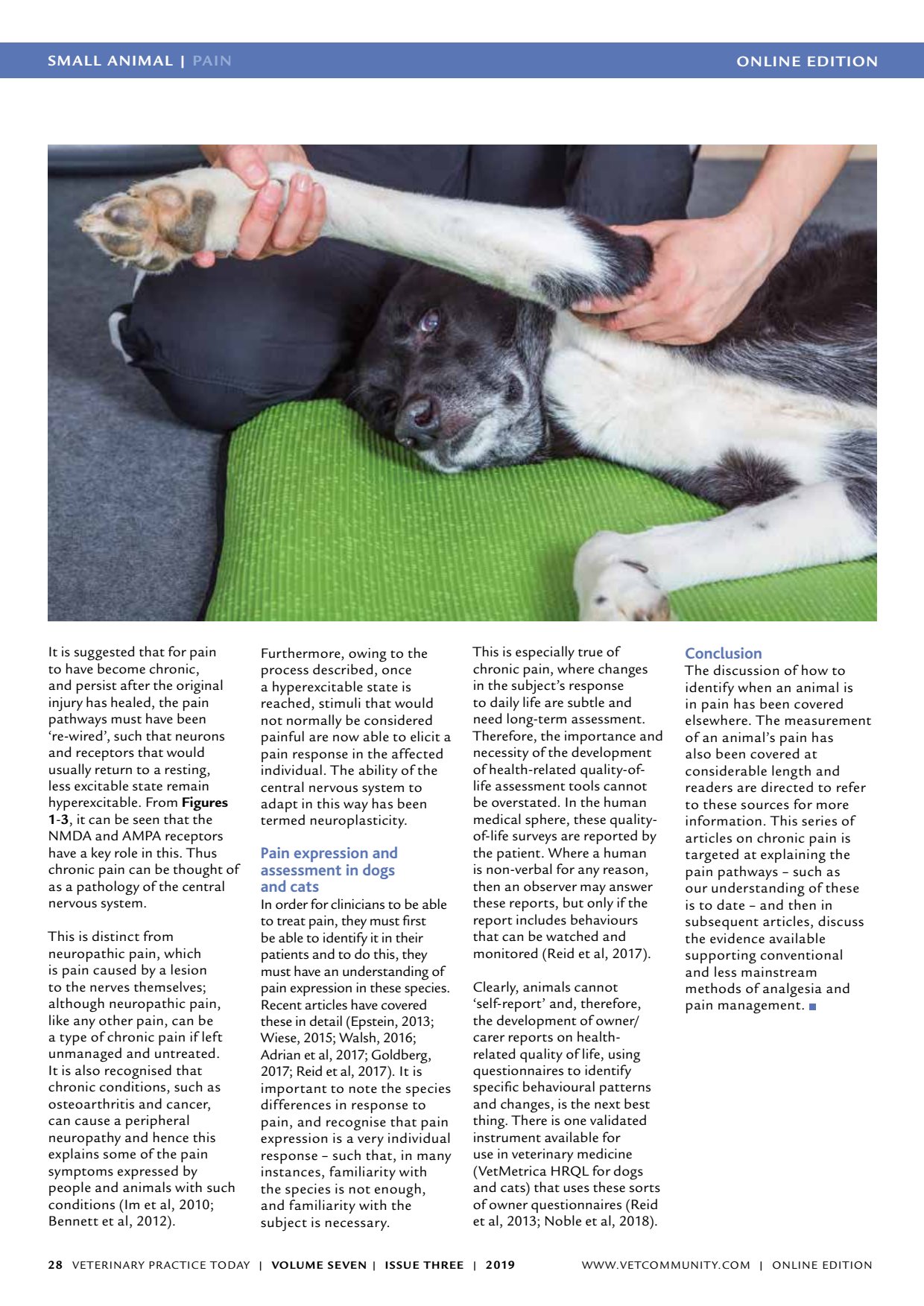Pain expression assessment
ONLINE EDITIONSMALL ANIMAL | PAIN VETERINARY PRACTICE TODAY | VOLUME SEVEN | ISSUE THREE | 2019 28 It is suggested that for pain to have become chronic, and persist after the original injury has healed, the pain pathways must have been re-wired, such that neurons and receptors that would usually return to a resting, less excitable state remain hyperexcitable. From Figures 1 - 3 , it can be seen that the NMDA and AMPA receptors have a key role in this. Thus chronic pain can be thought of as a pathology of the central nervous system. This is distinct from neuropathic pain, which is pain caused by a lesion to the nerves themselves; although neuropathic pain, like any other pain, can be a type of chronic pain if left unmanaged and untreated. It is also recognised that chronic conditions, such as osteoarthritis and cancer, can cause a peripheral neuropathy and hence this explains some of the pain symptoms expressed by people and animals with such conditions (Im et al, 2010; Bennett et al, 2012). Furthermore, owing to the process described, once a hyperexcitable state is reached, stimuli that would not normally be considered painful are now able to elicit a pain response in the affected individual. The ability of the central nervous system to adapt in this way has been termed neuroplasticity. Pain expression and assessment in dogs and cats In order for clinicians to be able to treat pain, they must first be able to identify it in their patients and to do this, they must have an understanding of pain expression in these species. Recent articles have covered these in detail (Epstein, 2013; Wiese, 2015; Walsh, 2016; Adrian et al, 2017; Goldberg, 2017; Reid et al, 2017). It is important to note the species differences in response to pain, and recognise that pain expression is a very individual response such that, in many instances, familiarity with the species is not enough, and familiarity with the subject is necessary. This is especially true of chronic pain, where changes in the subjects response to daily life are subtle and need long-term assessment. Therefore, the importance and necessity of the development of health-related quality-of- life assessment tools cannot be overstated. In the human medical sphere, these quality- of-life surveys are reported by the patient. Where a human is non-verbal for any reason, then an observer may answer these reports, but only if the report includes behaviours that can be watched and monitored (Reid et al, 2017). Clearly, animals cannot self-report and, therefore, the development of owner/ carer reports on health- related quality of life, using questionnaires to identify specific behavioural patterns and changes, is the next best thing. There is one validated instrument available for use in veterinary medicine (VetMetrica HRQL for dogs and cats) that uses these sorts of owner questionnaires (Reid et al, 2013; Noble et al, 2018). Conclusion The discussion of how to identify when an animal is in pain has been covered elsewhere. The measurement of an animals pain has also been covered at considerable length and readers are directed to refer to these sources for more information. This series of articles on chronic pain is targeted at explaining the pain pathways such as our understanding of these is to date and then in subsequent articles, discuss the evidence available supporting conventional and less mainstream methods of analgesia and pain management. WWW.VETCOMMUNIT Y.COM | ONLINE EDITION
